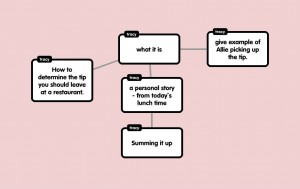I’m in the middle of a 2-day workshop on Flipping the Classroom for educational consultants and lead teachers. Since this post is really about my notes as I experience the day, a lot of it will be in note form. (makes sense, eh? :) )
The workshop took place bilingually, mainly in English, but everyone just spoke in the language they were most comfortable in and people jumped in to translate when someone needed explanation. Loved it.
Facilitators: Avi and Marc-Andre
Pre-workshop learning – Avi and Marc-Andre sent us these resources to view:
The Flipped Classroom, by Aaron Sams (2m15s): http://tinyurl.com/aaronflipped
The Flipped Classroom, by Jonathan Bergman (1m59s): http://tinyurl.com/jonathanflipped
Salman Khan: Let's use video to reinvent education: http://tinyurl.com/salmanflipped
The Flipping Classroom Infographic: Link <http://www.knewton.com/flipped-classroom/>
Morning Notes
We are here to give our honest feedback – as guinea pigs for future teacher workshops. `We` are a collection of consultants and lead teachers in tech at our centres / board. Mainly from the Adult Education sector but at least one person from the youth sector as well.
Their desired outcome — teachers get better at didactics
Word Swatch activity:
Discussion around difference and hierarchy of illustrate – show – explain
and…if one is done maladroitment … what is the impact?
Idea given by Marc-Andre that consulting could be flipped, too.
Asking us to watch videos and to create a rubric re: communication and concept (form and content) about these videos.
1 – form — hard to hear, whiteboard teaching about English concept … dry. Video equivalent of pedantic drivel. Long winded explanation. Even more painful on video than in real life.
2 – brought about convo around being cognizant of not making boring videos for students to watch at home
“no amount of rewinding can make up for weak pedagogy“ – Marc-Andre
talking about how teachers may need to go through the process of making `bad` videos in order to realize what is needed. Il faut trouver la bonne balance entre laisser les apprenants suivre leur processus et de jumping in and guiding them towards what works best. –> Facilitation – the dance between what people want and where we/they/their teaching practice needs to go (like in recent conversation around change models on HSI net…I may write more about this in another post)
3 – Conversation around what is a good and bad video = revealed that it is somewhat subjective. And sometimes our judgment of a video is coming from where we are at and not necessarily where a learner is at.
A big criticism of some of the videos (in particular the Kahn video) is that there is no reason for watching the video given. There is no context, no `why`. —> Creating the why, so very important in all learning situations, especially for adults? perhaps…
Importance of being cognizant of audience – and the why they are watching this. I see that this is no big difference between this and good teaching in general….
Conversation around teachers finding time to create presentations like this
- teachers should be paid to be trained (Marc-Andre says centres have money for this…)
- Avi talks about 90/10 – to start, 90% can be found videos and maybe 10% can be self-created
idea of judgment came up…Flipping the classroom in more ways than one
- – teaching happens at home, homework in class
- – teacher performs and is open to evaluation through existence of video evidence
If you are offering the idea to flip the classroom you have to be ready to receive constructive criticism
— fear for teachers? – when making video, we are more open to criticism and judgment. We can no longer close our doors and feel “safe“, in a sense.
Again – no matter the delivery, love of your students and of your subject shines through
(Paul offers – Barry Bennett (beyond Monet) has videos of good / bad teaching.)
Afternoon Notes
Looking at criteria for a `good` video
- Speaker – speed, formal/informal consistency, humour, recording quality, vocabulary, tone…
- Visuals and Audio – dynamic, music, speaker seen or not?,
- content – what, how, why,
Our first task:
First capsule – Audio Only (why? forces us to focus on explanation without relying on visual)
—> Explain how to determine the tip for a meal at a restaurant
Here is mine – I organized my ideas with popplet , a mind-mapping program that Avi showed us.

And then I started to talk and realized I needed a script, so wrote a script, then recorded it with audacity
leaveatip
And THEN, when I thought it was all done I found out that after I left the room to start working on my little mp3 the question was CHANGED. So my audio didn`t really answer the task per se but it does go into the idea of how to explain a concept. I used narrative, story-telling as my starting point. Others used role-play, others were more didactic.
Looking forward to tomorrow! Well, now it is today, so looking forward to later today when we continue :)

Leave a Reply to Tracy Cancel reply